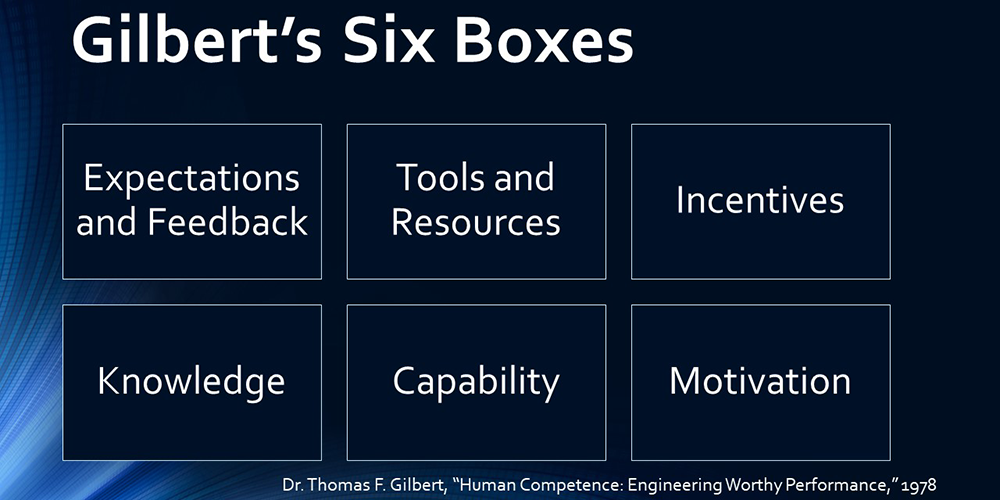In our last post, we explored the history and research behind Gilbert’s Six Box Performance Model—a framework that helps organizations diagnose and improve performance by focusing on the system rather than just the individual. One of the most influential voices in expanding and applying this model is Dr. Carl Binder, who coined the term “Six Boxes” and built upon Gilbert’s work. Binder’s contributions have helped organizations worldwide use the model not just as a diagnostic tool, but as a strategic framework for performance improvement and leadership development.
But what do these six boxes actually represent? How do they work together to drive worthy performance?
In this post, we’ll break down each of the six factors, explain how they influence performance, and provide real-world examples of how organizations use them to improve results.
The Six Box Model: Breaking It Down
Gilbert’s Six Box Performance Model suggests that human performance is shaped by six key factors—three related to the environment and three related to the individual.
These six elements determine whether people can perform effectively or if they struggle due to missing support, unclear expectations, or other barriers.
Let’s take a closer look at each box, how it impacts performance, and what organizations can do to optimize it.
Box 1: Information (Expectations & Feedback)
🔹 Definition: Do employees know what is expected of them? Are they receiving clear and timely feedback on their performance?
🔹 Common Problems:
- Unclear job roles or responsibilities
- Lack of performance metrics or success criteria
- Delayed or inconsistent feedback
- Miscommunication between leadership and employees
🔹 Real-World Example:
A customer service team at an e-commerce company struggled with low customer satisfaction scores. Managers assumed the agents needed more training, but an analysis using the Six Box Model found that expectations were unclear. Agents were given conflicting information on how to handle complaints, and feedback from supervisors was inconsistent.
🔹Solution: The company introduced a performance dashboard showing real-time customer satisfaction scores, set clear response guidelines, and implemented weekly coaching sessions. With better expectations and feedback, performance improved without additional training.
Box 2: Resources & Tools
🔹 Definition: Do employees have the materials, tools, and systems needed to perform effectively?
🔹 Common Problems:
- Outdated technology or software
- Lack of access to critical information
- Insufficient staffing or workload imbalance
- Poor working conditions
🔹 Real-World Example:
A hospital’s surgical team faced delays during procedures, leading to increased patient risks. Initially, leadership blamed a lack of staff training, but an assessment revealed that the surgical tools were not being restocked properly, causing surgeons to pause and wait for missing equipment.
🔹Solution: The hospital improved inventory tracking and implemented real-time stock alerts in operating rooms. The result? A 20% reduction in surgery delays, with no additional training required.
Box 3: Incentives & Motivation
🔹 Definition: Are rewards, recognition, and consequences aligned with desired performance?
🔹 Common Problems:
- Lack of financial or non-financial incentives
- Misaligned compensation structures
- No recognition for high performers
- Fear of punishment for taking risks
🔹 Real-World Example:
A sales team at a software company had low engagement despite offering performance bonuses. The problem? The bonus structure rewarded total revenue but didn’t account for customer retention. This led to aggressive sales tactics, but clients often canceled their contracts.
🔹Solution: The company revised its incentive model to include a bonus for customer retention over six months. Sales teams now focused on long-term relationships, increasing both retention rates and overall revenue.
Box 4: Knowledge & Skills (Training & Competence)
🔹 Definition: Do employees have the skills, knowledge, and experience necessary to perform?
🔹 Common Problems:
- Lack of training or outdated learning methods
- Poor onboarding for new employees
- Training doesn’t align with job needs
- Employees forget what they learned due to lack of reinforcement
🔹 Real-World Example:
A tech company noticed that many developers were struggling to adopt a new AI-based coding platform. Managers initially believed the issue was resistance to change. However, a performance analysis found that the training was outdated and didn’t provide hands-on practice.
🔹Solution: The company replaced passive video training with interactive coding simulations and AI-powered feedback tools. Within three months, developer adoption increased by 40%.
Box 5: Capacity & Individual Ability
🔹 Definition: Do employees have the physical, mental, or emotional ability to perform?
🔹 Common Problems:
- Employees are overworked or burned out
- High physical or cognitive demands that reduce effectiveness
- Hiring people who lack the natural aptitude for the role
- Health or wellness issues affecting performance
🔹 Real-World Example:
A manufacturing plant had high turnover among machine operators. Supervisors assumed workers were quitting due to low pay, but an assessment showed that the job required extreme focus for long shifts, leading to burnout.
🔹 Solution: The company introduced more frequent breaks and rotated employees between stations to reduce cognitive fatigue. Turnover rates dropped by 30%.
Box 6: Motivation & Cultural Fit
🔹 Definition: Do employees want to perform well? Does the organizational culture support high performance?
🔹 Common Problems:
- Lack of alignment between personal values and company culture
- Employees feel disengaged or unfulfilled
- No sense of purpose in their work
- Toxic workplace culture discouraging innovation
🔹 Real-World Example:
A nonprofit organization struggled to retain talented employees, even though salaries were competitive. After conducting exit interviews, leadership discovered that employees felt disconnected from the mission and lacked a sense of purpose.
🔹Solution: The nonprofit created a mentorship program connecting new employees with leaders who had deep ties to the organization’s work. Engagement and retention improved as employees felt more connected to their impact.
How the Six Boxes Work Together
One of the biggest mistakes companies make is focusing only on one box while ignoring others.
For example:
- If employees lack skills (Box 4), but also lack the right tools (Box 2), training alone won’t solve the problem.
- If expectations aren’t clear (Box 1), motivation and incentives (Box 3) won’t drive performance effectively.
- If employees are overworked (Box 5), no amount of training (Box 4) will fix their productivity.
By analyzing all six factors together, organizations can pinpoint real performance issues and implement solutions that actually work.
Applying the Six Box Model in Your Organization
Dr. Gilbert’s Six Box Performance Model remains one of the most powerful tools for diagnosing and improving performance. By understanding the role of information, tools, incentives, training, capacity, and motivation, leaders can design better work environments where employees succeed naturally—without excessive micromanagement, punishment, or wasted training investments.

